移动通信试题库
移动通信技术考试试题
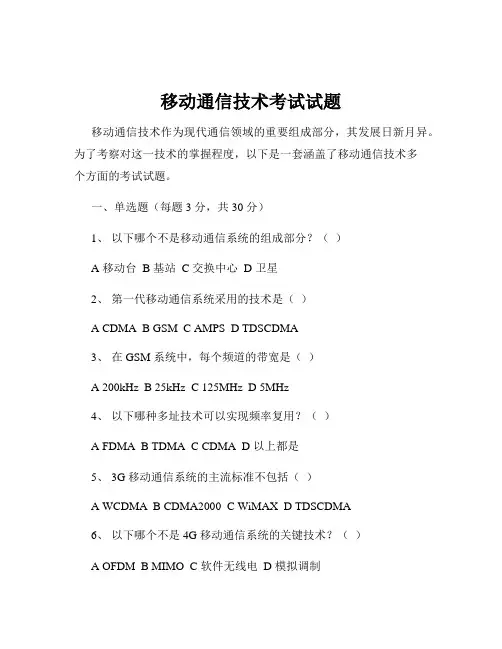
移动通信技术考试试题移动通信技术作为现代通信领域的重要组成部分,其发展日新月异。
为了考察对这一技术的掌握程度,以下是一套涵盖了移动通信技术多个方面的考试试题。
一、单选题(每题 3 分,共 30 分)1、以下哪个不是移动通信系统的组成部分?()A 移动台B 基站C 交换中心D 卫星2、第一代移动通信系统采用的技术是()A CDMAB GSMC AMPSD TDSCDMA3、在 GSM 系统中,每个频道的带宽是()A 200kHzB 25kHzC 125MHzD 5MHz4、以下哪种多址技术可以实现频率复用?()A FDMAB TDMAC CDMAD 以上都是5、 3G 移动通信系统的主流标准不包括()A WCDMAB CDMA2000C WiMAXD TDSCDMA6、以下哪个不是 4G 移动通信系统的关键技术?()A OFDMB MIMOC 软件无线电D 模拟调制7、在 LTE 系统中,控制平面的协议栈不包括()A RRCB PDCPC RLCD TCP8、 5G 移动通信系统中,以下哪个频段属于毫米波频段?()A 3GHz 以下B 3 6GHzC 24GHz 以上D 6 24GHz9、以下哪种技术可以提高移动通信系统的容量?()A 小区分裂B 频率规划C 功率控制D 以上都是10、以下哪个不是移动通信中的衰落类型?()A 路径损耗B 阴影衰落C 多径衰落D 频率衰落二、多选题(每题 5 分,共 30 分)1、以下属于移动通信信道特点的有()A 衰落B 干扰C 多普勒频移D 多径传播2、 2G 移动通信系统中的安全机制包括()A 用户认证B 加密C 设备识别D 位置登记3、 3G 移动通信系统中的切换类型包括()A 硬切换B 软切换C 更软切换D 接力切换4、 4G 移动通信系统中的网络架构包括()A EPCB eNodeBC MMED SGW5、 5G 移动通信系统中的应用场景包括()A eMBB B mMTC C URLLCD V2X6、以下属于移动通信中的功率控制技术的有()A 开环功率控制B 闭环功率控制C 内环功率控制D 外环功率控制三、简答题(每题 10 分,共 20 分)1、简述 GSM 系统的帧结构。
移动通信技术基础试题含答案
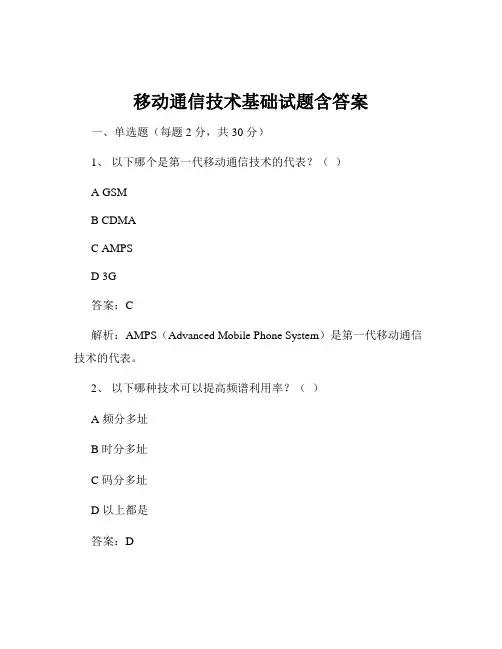
移动通信技术基础试题含答案一、单选题(每题 2 分,共 30 分)1、以下哪个是第一代移动通信技术的代表?()A GSMB CDMAC AMPSD 3G答案:C解析:AMPS(Advanced Mobile Phone System)是第一代移动通信技术的代表。
2、以下哪种技术可以提高频谱利用率?()A 频分多址B 时分多址C 码分多址D 以上都是答案:D解析:频分多址、时分多址和码分多址都可以在不同程度上提高频谱利用率。
3、以下哪个频段通常用于移动通信?()A 低频段B 中频段C 高频段D 以上都是答案:D解析:移动通信会使用从低频段到高频段的各种频段,以满足不同的覆盖和容量需求。
4、以下哪种调制方式在移动通信中应用广泛?()A 幅度调制B 频率调制C 相位调制D 以上都是答案:D解析:幅度调制、频率调制和相位调制在移动通信中都有应用。
5、蜂窝移动通信系统中,小区分裂的主要目的是()A 增加容量B 扩大覆盖范围C 提高信号质量D 降低干扰答案:A解析:小区分裂可以增加系统容量,以满足更多用户的需求。
6、以下哪个不是 4G 移动通信的关键技术?()A OFDMB MIMOC 智能天线D 蓝牙答案:D解析:蓝牙不是 4G 移动通信的关键技术。
7、以下哪种技术可以实现多个用户同时共享同一频段?()A 单工通信B 双工通信C 半双工通信D 以上都不是答案:D解析:CDMA(码分多址)技术可以实现多个用户同时共享同一频段。
8、移动台在空闲状态下的小区选择和重选是由()决定的。
A 网络B 移动台C 基站D 核心网答案:B解析:移动台在空闲状态下自主进行小区选择和重选。
9、在 GSM 系统中,用于鉴权和加密的三参数组不包括()A RANDB SRESC KcD TMSI答案:D解析:TMSI 不是用于鉴权和加密的三参数组。
10、以下哪个不是 5G 移动通信的应用场景?()A 增强移动宽带B 大规模物联网C 低时延高可靠通信D 模拟电视广播答案:D解析:模拟电视广播不是 5G 移动通信的应用场景。
移动通信试题库-填空题
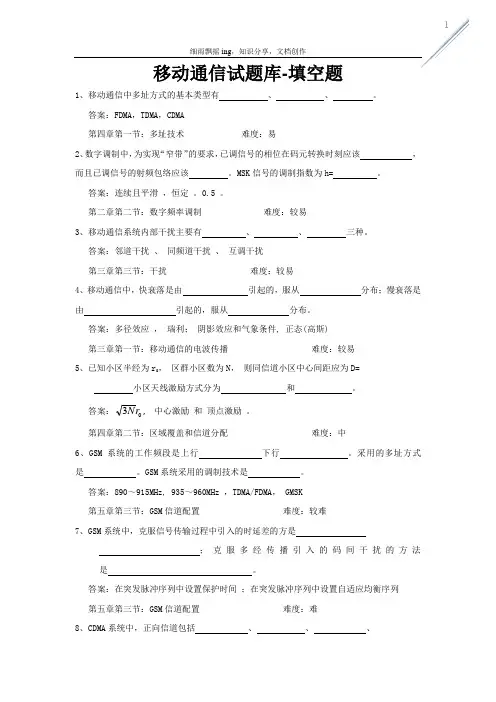
移动通信试题库-填空题 1、移动通信中多址方式的基本类型有 、 、 。
答案:FDMA ,TDMA ,CDMA第四章第一节:多址技术 难度:易2、数字调制中,为实现“窄带”的要求,已调信号的相位在码元转换时刻应该 ,而且已调信号的射频包络应该 。
MSK 信号的调制指数为h= 。
答案:连续且平滑 ,恒定 。
0.5 。
第二章第二节:数字频率调制 难度:较易 3、移动通信系统内部干扰主要有 、 、 三种。
答案:邻道干扰 、 同频道干扰 、 互调干扰第三章第三节:干扰 难度:较易4、移动通信中,快衰落是由 引起的,服从 分布;慢衰落是由 引起的,服从 分布。
答案:多径效应 , 瑞利; 阴影效应和气象条件, 正态(高斯)第三章第一节:移动通信的电波传播 难度:较易5、已知小区半经为r 0, 区群小区数为N , 则同信道小区中心间距应为D=小区天线激励方式分为 和 。
答案:03r N , 中心激励 和 顶点激励 。
第四章第二节:区域覆盖和信道分配 难度:中6、GSM 系统的工作频段是上行 下行 。
采用的多址方式是 。
GSM 系统采用的调制技术是 。
答案:890~915MHz, 935~960MHz ,TDMA/FDMA , GMSK第五章第三节:GSM 信道配置 难度:较难7、GSM 系统中,克服信号传输过程中引入的时延差的方是;克服多经传播引入的码间干扰的方法是 。
答案:在突发脉冲序列中设置保护时间 ;在突发脉冲序列中设置自适应均衡序列第五章第三节:GSM 信道配置 难度:难 8、CDMA 系统中,正向信道包括 、 、 、。
反向信道包括、。
CDMA中采用正向功率控制是为了减少;采用反向功率控制是为了。
答案:导频信道、同步信道、寻呼信道、正向业务信道、反向业务信道、反向接入信道 . 多址干扰;远近效应第六章第二节:CDMA数字蜂窝网通信系统难度:难9、第三代移动通信系统的主流技术是。
被国际电信联盟ITU采纳的第三代移动通信系统的标准主要有、、。
移动通信试题及答案
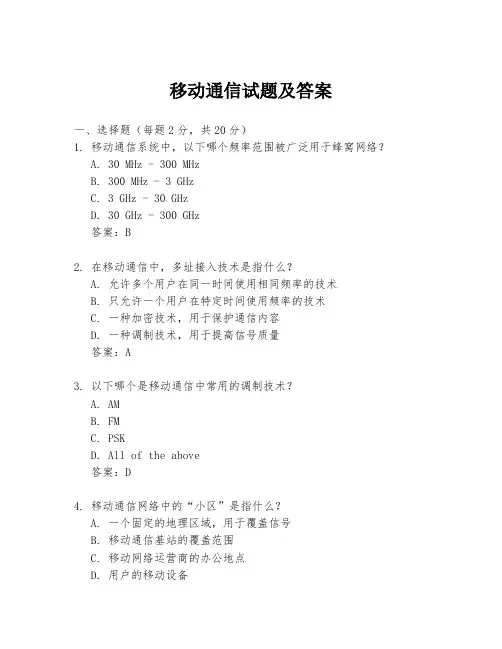
移动通信试题及答案一、选择题(每题2分,共20分)1. 移动通信系统中,以下哪个频率范围被广泛用于蜂窝网络?A. 30 MHz - 300 MHzB. 300 MHz - 3 GHzC. 3 GHz - 30 GHzD. 30 GHz - 300 GHz答案:B2. 在移动通信中,多址接入技术是指什么?A. 允许多个用户在同一时间使用相同频率的技术B. 只允许一个用户在特定时间使用频率的技术C. 一种加密技术,用于保护通信内容D. 一种调制技术,用于提高信号质量答案:A3. 以下哪个是移动通信中常用的调制技术?A. AMB. FMC. PSKD. All of the above答案:D4. 移动通信网络中的“小区”是指什么?A. 一个固定的地理区域,用于覆盖信号B. 移动通信基站的覆盖范围C. 移动网络运营商的办公地点D. 用户的移动设备答案:B5. 移动通信中的“切换”通常指的是什么?A. 用户从一个小区移动到另一个小区时,通信信号的转移B. 更换移动设备的操作系统C. 更换移动设备的SIM卡D. 更换移动网络运营商答案:A6. 以下哪个是第三代移动通信技术(3G)的主要特点?A. 提供更高的数据传输速率B. 只能用于语音通信C. 需要更大的基站天线D. 仅限于固定位置使用答案:A7. 4G LTE网络相比于3G网络,其主要优势是什么?A. 更低的数据传输速率B. 更高的网络延迟C. 更低的能耗D. 更快的数据传输速率答案:D8. 移动通信中的“信号衰减”通常是由什么原因引起的?A. 信号在传播过程中的能量损失B. 移动设备的电池电量不足C. 天气晴朗D. 用户距离基站过近答案:A9. 在移动通信中,什么是“带宽”?A. 信号传输的最大距离B. 信号传输的最大速率C. 信号的频率范围D. 移动设备的尺寸答案:C10. 以下哪个是移动通信中的错误编码技术?A. TCPB. UDPC. FECD. HTTP答案:C二、填空题(每题2分,共20分)11. 移动通信中的“_____”技术可以有效地减少信号干扰,提高通信质量。
移动通信技术考试试题与答案
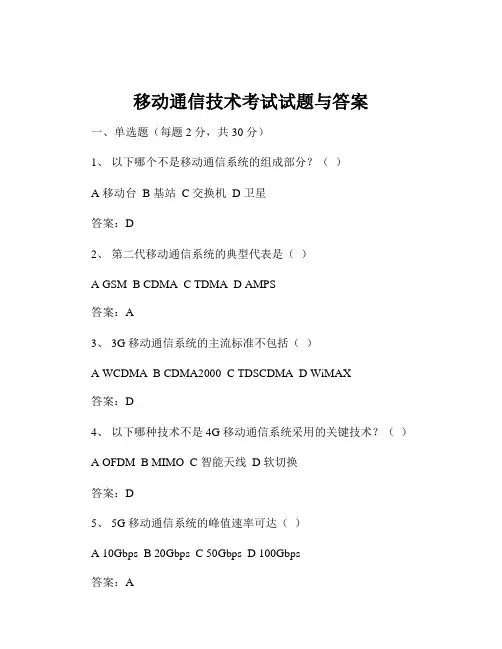
移动通信技术考试试题与答案一、单选题(每题 2 分,共 30 分)1、以下哪个不是移动通信系统的组成部分?()A 移动台B 基站C 交换机D 卫星答案:D2、第二代移动通信系统的典型代表是()A GSMB CDMAC TDMAD AMPS答案:A3、 3G 移动通信系统的主流标准不包括()A WCDMAB CDMA2000C TDSCDMAD WiMAX答案:D4、以下哪种技术不是 4G 移动通信系统采用的关键技术?()A OFDMB MIMOC 智能天线D 软切换答案:D5、 5G 移动通信系统的峰值速率可达()A 10GbpsB 20GbpsC 50GbpsD 100Gbps答案:A6、移动通信中的多址技术不包括()A FDMAB TDMAC CDMAD SDMA答案:D7、在 GSM 系统中,每个频道的带宽是()A 200kHzB 25kHzC 125MHzD 5MHz答案:A8、码分多址(CDMA)的特点是()A 频率复用率高B 保密性好C 容量大D 以上都是答案:D9、以下哪个不是移动通信中的切换类型?()A 硬切换B 软切换C 更软切换D 随机切换答案:D10、手机在通话过程中,从一个基站覆盖区移动到另一个基站覆盖区时,保持通话不中断的技术称为()A 位置更新B 切换C 漫游D 小区重选答案:B11、以下哪个频段常用于移动通信?()A 甚低频B 特高频C 极高频D 以上都是答案:B12、移动通信中的分集技术主要用于()A 抗衰落B 增加容量C 提高频谱利用率D 以上都是答案:A13、在 LTE 系统中,采用的调制方式不包括()A QPSKB 16QAMC 64QAMD 256QAM答案:D14、 5G 网络中,实现低时延的关键技术是()A 大规模 MIMOB 网络切片C 边缘计算D 毫米波通信答案:C15、以下哪个不是 5G 应用场景?()A eMBB B mMTC C URLLCD WiFi答案:D二、多选题(每题 3 分,共 30 分)1、移动通信的特点包括()A 移动性B 电波传播条件复杂C 噪声和干扰严重D 系统和网络结构复杂答案:ABCD2、 4G 移动通信系统的网络架构包括()A 核心网B 接入网C 承载网D 业务网答案:ABC3、以下属于 5G 关键性能指标的是()A 峰值速率B 用户体验速率C 流量密度D 连接数密度答案:ABCD4、移动通信中的编码技术包括()A 信源编码B 信道编码C 加密编码D 调制编码答案:ABC5、 GSM 系统中的控制信道包括()A 广播信道B 公共控制信道C 专用控制信道D 业务信道答案:ABC6、以下哪些是 CDMA 系统的优点?()A 抗干扰能力强B 容量大C 保密性好D 切换成功率高答案:ABCD7、 4G 网络中的 MIMO 技术可以实现()A 空间复用B 空间分集C 波束赋形D 以上都是答案:D8、 5G 网络切片的特点包括()A 定制化B 隔离性C 灵活性D 以上都是答案:D9、移动通信中的功率控制的目的是()A 克服远近效应B 减少干扰C 延长电池寿命D 以上都是答案:D10、以下哪些是 5G 面临的挑战?()A 高频段覆盖问题B 能耗问题C 安全问题D 以上都是答案:D三、简答题(每题 10 分,共 30 分)1、简述 GSM 系统的组成及各部分的功能。
移动通信技术考试题与答案
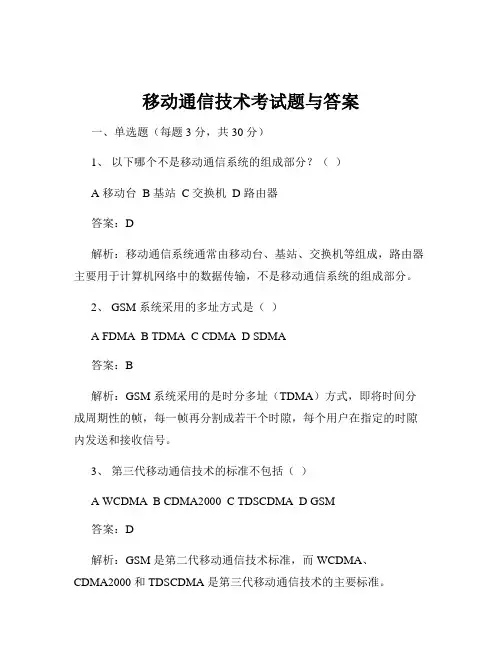
移动通信技术考试题与答案一、单选题(每题 3 分,共 30 分)1、以下哪个不是移动通信系统的组成部分?()A 移动台B 基站C 交换机D 路由器答案:D解析:移动通信系统通常由移动台、基站、交换机等组成,路由器主要用于计算机网络中的数据传输,不是移动通信系统的组成部分。
2、 GSM 系统采用的多址方式是()A FDMAB TDMAC CDMAD SDMA答案:B解析:GSM 系统采用的是时分多址(TDMA)方式,即将时间分成周期性的帧,每一帧再分割成若干个时隙,每个用户在指定的时隙内发送和接收信号。
3、第三代移动通信技术的标准不包括()A WCDMAB CDMA2000C TDSCDMAD GSM答案:D解析:GSM 是第二代移动通信技术标准,而 WCDMA、CDMA2000 和 TDSCDMA 是第三代移动通信技术的主要标准。
4、以下哪个频段常用于移动通信?()A 低频段B 中频段C 高频段D 以上都是答案:D解析:移动通信会使用从低频段到高频段的各种频段,以满足不同的覆盖范围和传输需求。
5、码分多址技术的特点是()A 抗干扰能力强B 频谱利用率高C 保密性好D 以上都是答案:D解析:码分多址(CDMA)技术具有抗干扰能力强、频谱利用率高、保密性好等优点。
6、移动台在空闲状态下的小区选择是基于()A 信号强度B 信号质量C 优先级D 以上都是答案:D解析:移动台在空闲状态下进行小区选择时,会综合考虑信号强度、信号质量和优先级等因素。
7、以下哪个不是 4G 移动通信系统的关键技术?()A OFDMB MIMOC 智能天线D 电路交换答案:D解析:4G 移动通信系统采用的是分组交换技术,而非电路交换。
OFDM(正交频分复用)、MIMO(多输入多输出)和智能天线都是4G 的关键技术。
8、 5G 移动通信的峰值速率可达()A 1GbpsB 10GbpsC 20GbpsD 50Gbps答案:B解析:5G 移动通信的峰值速率可达 10Gbps 以上。
《移动通信原理》复习试题整理
《移动通信原理》复习试题整理一、选择题1、移动通信系统中,用于区分不同用户的是()A 频率B 时隙C 码型D 以上都是答案:D解析:在移动通信系统中,频率、时隙和码型都可以用于区分不同的用户,以实现多用户同时通信。
2、以下哪种多址接入技术适合大容量、高速数据传输?()A FDMAB TDMAC CDMAD SDMA答案:C解析:CDMA(码分多址)具有抗干扰能力强、容量大、保密性好等优点,适合大容量、高速数据传输。
3、移动通信中的衰落主要包括()A 快衰落B 慢衰落C 瑞利衰落D 以上都是答案:D解析:移动通信中的衰落包括快衰落、慢衰落和瑞利衰落等多种类型。
快衰落是由于多径传播引起的短时间内信号强度的快速变化;慢衰落则是由于障碍物遮挡等原因导致的长时间内信号强度的缓慢变化;瑞利衰落是一种常见的快衰落形式。
4、下面哪个频段常用于移动通信?()A 低频段B 中频段C 高频段D 以上都是答案:D解析:移动通信系统会根据不同的应用场景和需求,使用低、中、高不同频段。
低频段传播特性好,但频谱资源有限;中频段兼顾传播和频谱资源;高频段频谱资源丰富,但传播特性相对较差。
5、蜂窝移动通信系统中,小区分裂的主要目的是()A 增加容量B 提高覆盖C 降低干扰D 以上都是答案:A解析:随着用户数量的增加,原有的小区容量可能无法满足需求,通过小区分裂可以增加小区数量,从而增加系统容量。
二、填空题1、移动通信中的切换包括________切换和________切换。
答案:硬切换软切换解析:硬切换是指在新的连接建立之前先断开旧的连接;软切换则是在新的连接建立之后再断开旧的连接。
2、常见的移动通信信道编码方式有________、________等。
答案:卷积码 Turbo 码解析:卷积码和 Turbo 码在移动通信中被广泛应用,用于提高信道传输的可靠性。
3、第三代移动通信的标准主要有________、________和________。
移动通信试题库完整版
移动通信技术试题库一、填空题1、IMSI 号码用来识别每个移动用户,并且存储在一SIM 卡上:2、TMSI___号码是用来替换在无线接口的IMSI,以增加用户数据的保密性3、HLR的全称是―归届位置寄存器;4、GMS旋称是移动接口局;5、PLMN网络包括两部分:一个一网络系统和一个「无线系统;6、BSC是基站BS的智能中心,其主要功能是控制BST7、用户手机和GS嶙统网络部分的互通接口是_Um 接口;8、一个MSCM由一个或若干个LA 组成:9、基带跳频中,跳频数受限丁收发信台接接的数目;10、DT刈勺全称为不连续接受;11、射频跳频时,支持BCCH的信道不参和跳频;12、利用一定距离的两幅天线接收同一信号,称为接空间分集;13、常用的合并技术有最大增益、等增益、选择式14、扩频系统常指利用带宽接100接倍以上的系统处理增益;15、在CDM冲,有直序扩频系统和跳频扩频系统:30、GS咖,主频C0上映射的控制信道包括_ _t;17、CDM嫉统的一个信道宽是 1.2288 MHz18、CDM嫉统采用Rake ____ 接收机进行路径分集;19、CDM嫉统前向信道有―个正交码分信道;20、CDM原统中的前向业务信道全速率是9.6 kbps :21、GS崎统的载频间隔是接200__kHz22、GS崎统的数据传输全速率是9.6 kbps :23、GSM勺跳频速率是217 跳每秒:24、GSM、信道速率为270.8 kbps ;25、LPC是指线性预测编码;26、GS崎统中每20ms包含了接160』羊本、共_260接bit,其速率是13 kbit/s ;27、GS崎统常采用的信道编码,是利用码率为接1/2接接的卷积码:28、GS咖,每个突发脉冲序列共__156.25 bit,占时 4.615一ms;29、G S咖,BCCH言道是映射到主频的TS0 时隙;30、GS咖,主频C0上映射的信道包括 6 个TCH31、I S-95CDM必届丁第2 代移动通信系统;32、3G主流技术标准包括CDMA200=、TD-SCDMA 和W-CDMA ;33、移动通信采用的常见多址方式有FDMA、TDMA和CDMA、34、以铜线接入为主的ADSLfe术称为,它支持下行最局速率8 Mbit/s ,上行最局速率Mbit/s。
移动通信试题库及答案全完整
移动通信试题库 .10一、填空题1. ____个人通信______是人类通信最高目的,它是用各种也许网络技术实现任何人在任何时间、任何地点与任何人进行任何种类____信息互换_____。
2.移动通信系统中影响电波传播3种最基本机制为___反射____、__绕射_____和____散射___。
3.在CDMA系统中从通信链路角度看,功率控制分为___反向链路功率控制____和__前向链路功率控制;4.依照切换发生时,移动台与原基站以及目的基站连接方式不同,可以将切换分为____软切换_______和_______硬切换_____两大类。
5.WCDMA信道带宽是____5M码片/s_______,码片速率是____3.84M/码片/s_______。
6.IS-95A下行链路运用码分物理信道传送不同信息,按照所传送信息功能不同而分类信道称为逻辑信道;IS-95A下行链路中逻辑信道涉及如下四种_____导频信道______、____同步信道_______、____寻呼信道_______和_____下行业务信道______。
7.HSDPA中文意思是___高速下行分组接入技术________。
8.1个64QAM调制符号代表__28M___位信息比特。
9.TD-SCDMA基本物理信道特性有____频率____、___时隙_____和____码片____决定。
10.CDMA系统中,移动台将导频提成4个导频集,分别是_激活集__、_候选集_、__相邻集__和___剩余集。
11. TD-SCDMA一种信道带宽是 1.6 MHz,码片速率为 1.28 Mcps。
12. 在CDMA系统中从功率控制办法角度看,功率控制分为___开环功率控制_和__闭环功率控制__。
13. TD-SCDMA信道带宽是____1.6MHz _______、码片速率是____1.28Mcps _______。
14. GSM一种载频带宽是____200KHz_______,可提供___8____个物理信道。
移动通信试题库
移动通信一、单选B1.标准的有线传输采用脉冲编码调制(PCM),每秒钟抽样(D)次,每次抽样值用8ht来表示,总的码率是64kbps。
A、400B、800C、4000D、80002、BSC依据测量所得数据,进行计算,进而决定如何进行功率控制。
若认为MS发射电平过高,( A )s8b2_5yA、BSC可通知MS降低发射功率B、BSC可要求BTS降低发射功率C、BSC要求BTS提高发射功率D、BSC可通知MS提高发射功率 | 国内C1、CDMA系统为每个用户分配了各自特定的( D ),它可在一个信道上同时传输多个用户的信息。
A、波束B、时隙C、频率D、地址码2、CDMA通信在软切换时,移动台与多个基站同时联系,从中选取最好的信号送给交换机,这是一种(C)分集形式A、频率B、时间C、空间D、极化3.CDMA软切换的特性之一是(B )(A)先断原来的业务信道,再建立信道业务信道(B)在切换区域MS与两个BTS连接(C)在两个时隙间进行的(D)以上都不是4、采用分集技术时,最好的合并方式是哪个( A )A. 最佳比值合并B. 等增益合并C. 选择式合并242 长码在反向信道中用于_____D_______。
5.CDMA系统1A.扰码B.区分移动台C.区分基站D.以上均可6、CDMA码分多址的特点 ( ABCD )A. 网内所有用户使用同一载频、占用相同的带宽B.用Walsh码区分移动用户C.小区内可以有一个或多个载波D.采用跳频技术,跳频序列是正交的7、处于空闲模式下的手机所需的大量网络信息来自( A )信道A. BCCHB. CBCHC. RACHD. SDCCH8、CDMA的关键技术包括下列的( ABCD )A、频率复用技术B、软切换C、功率控制D、语音编码9、CDMA系统中的地址码和扩频码都包含( ABC )A. Walsh码B. m序列码C. Gold码10、CDMA的主要特点是( ABCDEF )A.大容量B.软容量C. 高的话音质量D.低发射功率E.话音激活F.保密11、CDMA的关键技术有( ABCDEF )A.功率控制B.分集接收C.软切换D.可变速率声码器E. RAKE接收F.自适应天线12、 CDMA系统的有效频带宽度1.2288MHz,语音编码速率为9.6kb/s,比特能量与噪声密度比为6dB,则系统容量为( C )A. 30B. 22C. 33D. 40D1.当手机关机,而MSC一直未收到(B)不可及的消息,它就必须对手机不断地进行寻呼。
- 1、下载文档前请自行甄别文档内容的完整性,平台不提供额外的编辑、内容补充、找答案等附加服务。
- 2、"仅部分预览"的文档,不可在线预览部分如存在完整性等问题,可反馈申请退款(可完整预览的文档不适用该条件!)。
- 3、如文档侵犯您的权益,请联系客服反馈,我们会尽快为您处理(人工客服工作时间:9:00-18:30)。
名词解释1.Explain the difference between hard and soft handoff.Answers:The hard handoff is that when the signal strength of a neighboring cell exceeds that of the current cell, plus a threshold, the mobile station is instructed to switch to a new frequency band that is within the allocation of the new cell. The soft handoff is that a mobile station is temporarily connected to more than one base station simultaneously. A mobile unit may start out assigned to a single cell. If the unit enters a region in which the transmissions from two base stations are comparable, the mobile unit enters the soft handoff state until which it is connected to the two base stations.2.What are the cores techniques of WCDMA?Answers: The WCDMA key techniques mostly consist of the power control technique, PN code technique, RSKE, Soft Handoff, and Speech coding.3.What is attenuation?4.What two functions are performed by an antenna?5.What are the advantages of using CDMA for a cellular network?Answers:(1)Frequency diversity; (2) Multipath resistance; (3) Privacy; (4) Gracefue degradation.6. What are the key differences between first and second generation cellular system? Answers: The key differences between the two generations:(1). Digital traffic channels; (2). Encryption; (3). Error detection correction;(4). Channel access.7. What are the cores techniques of TD-SCDMA?Answers: The cores techniques of TD-SCDMA are smart antenna (intelligent antenna), joint examination technique, SCDMA technique, software wireless technique, and dynamic channel allocation technique8. What is direct broadcast satellite (DBS)?Answers: The satellite video signals are transmission directly to the home user.9. What is an isotropic antenna?Answers:An isotropic antenna is a point in space that radiates power in all direction equally.10. What is CDMA?Answers: CDMA is a multiplexing technique used with spread spectrum11. What is frequency hopping spread spectrum?Answers: The signal is broadcast over a seemingly random series of radio frequency, hopping from frequency to frequency at fixed intervals12.What are the primary causes of atmospheric attenuation for satellite communications? Answers: The primary causes of atmospheric attenuation are oxygen and water13.What is a SIR?Answers: This ratio is defined to be the ratio of the desired average signal power at a receiver to the total average interference power.14.What are features of CDMA?Answers:(1) High spectrum efficiency(2)Release from frequency management(3)Low mobile station transmit power (4)Soft-handover (5)Path Diversity (RAKE Fingers) (6)Security (7)Anti-jamming capability15.In general, physical models include three basic modes of propagation.Answers:(1)Free-space or link-of-signal transmission;(2)Reflection;(3)Diffraction.16.In time, as more customers use the the system, traffic may build up so that there are not enough frequency bands assigned to a cell to handle its calls. A number of approaches have been used to cope with this situation, including the following。
Answers: (1)Adding new channels;(2)Frequency borrowing;(3)Cell splitting;(4)Cell sectoring;(5)Microcells。
17.Explain the difference between open-loop and closed-loop power control.Answers: Open-loop power control depends solely on the mobile unit, with no feedback from the BS.Closed-loop power control adjusts signal strength in the reverse channel based on some metric of performance in that reverse channel.18.Define channel capacity.Answers: The maximum rate at which data can be transmitted over a given communication path, or channel, under given conditions is referred to the channelcapacity.填空题1.Antenna characteristics are essentially the same whether an antenna is sendingor receiving electromagnetic energy.2.The basis for analog signaling is a continuous constant frequency signal known as the carrier signal.3.Nikola Tesla invented the wireless telegraph in 1893 .4.A transmission from earth station to satellite is referred to as uplink in the satellite communication.5.The essence of a cellular network is the use of multiple low-power transmitters, on orderof 100W or less.6.Third generation system generally call WCDMA or UMTS .7.Adjacent cells are assigned different frequencies to avoid interference or crosstalk.8.Viewed as a function of, an electromagnetic signal can be either analog or digital.An analog signal is one in which the signal intensity varies in a smooth fashion over time.9.The data signaling rate, or just data rate , of a signal is the rate, in bits per second, that data are transmitted.10The TD-SCDMA is a multiple connect into include the FCDMA/TDMA/CDMA11. Nikola Tesla invented the wireless telegraph in 1893.12.A digital signal is one in which the signal intensity maintains a constant level for some period of time and then changes to another constant level.13. Reflection occurs when an electromagnetic signal encounters a surface that is large relative to the wavelength of the signal.14.If the size of an obstacle is on the order of the wavelength of the signal orless scattering occurs.15. For a data of R , the duration of a bit is R T 1 seconds and the duration of a signal elementisLTTSseconds. If CTis greater then or to ST, the spreading modulation is referred toas slow-frequency-hop spread spectrum; otherwise it is known as fast-frequency-hop spread spectrum.16.A transmission from satellite station to earth is referred to as downlink in the satellite communication.17.The cells sufficiently distant from each other can use the same frequency band18.Code division multiple access is a spread spectrum based technique for multiplexing.19.The objective of the third generation of wireless communication is to provide fairly high speed wireless communications to support multimedia, data, and video in addition to voice.20.Power control technique is core in the CDMA .21.One purpose of the data-layer is to perform error correction or detection.22.The channel provides the physical means for transporting the signal produced by the transmitter and delivering it to the receiver .24.The key physical resource is the radio spectrum in wireless system.24.A digital signal is one in which the signal intensity maintains a constant level for some period of time and then changes to another constant level.25.The frequency is the rate at which the signal repeats.26.An antenna that transmits equally in all directions called the isotropic radiatio .27.Noise can be defined as unwanted electrical signals interference with the desired signal.28.The basic idea with cellular system is to reuse channel in different cell, increasing the capacity29.During the period from 1895 to 1901 , Guglielmo Marconi developed an apparatus for transmitting radio waves over longer distances.30.An electromagnetic signal can be either analog or digital. An analog signalis one in which the signal intensity varies in a smooth fashion over time.31.The spectrum of a signal is the range of frequencies that it contains.1.32.The same frequency assignments cannot be made in adjacent cell because ofinter-channel interference.33.Handoff may be network initiated.34.That each user occupies a cyclically repeating time slot in the TDMA system.35.All users in a CDMA , use the same carrier frequency and may transmit simultaneously.36.Self-jamming is a problem in CDMA system.37.The GSM key technique consist of eight parts38. Reflection occurs when an electromagnetic signal encounters a surface that is largerelative to the wavelength of the signal.判断题1. Thermal noise can be eliminated. ( N )2. The time-selective channels are time-invariant channels. ( N )3. A high SNR will mean a high-quality signal. ( Y )4. Free-space propagation, in which the received power decreases as the square of the distancefrom the transmitter. ( Y )5. Fast fading is the rapid variation of signal levels when the user terminal moves short distances. ( Y )6. Traffic channels are used to exchange information. ( N )7. Multiple access schemes are used to allow many mobile users to share simultaneously a finiteamount of radio spectrum. ( Y )8.Direct sequence multiple access is also called code division multiple access (CDMA). ( Y )9. The most popular second generation standards include three TDMA standards and one CDMAstandard. ( Y )10. The NS controls handoff between cell in different BSSs, authenticates users and validatestheir accounts, and includes functions for enabling worldwide roaming of mobile users. ( Y )11. Thermal noise cannot be eliminated. ( Y )12. Frequency-Selective Channels is time-invariant channels. ( N )13. The greater the bandwidth, the higher the information-carrying capacity. . ( Y )14.Reflection, wherein, for the plane-Earth model, the received power decreases as the fourthpower of distance. ( Y )15.Slow fading arises from the fact that most of the large reflectors and diffracting objectsalong the transmission path are distant from the terminal. ( Y )16.Control channels are used to exchange information. ( Y )17. That each user occupies a cyclically repeating time slot in the FDMA system. ( N )18.Many users of a CDMA system share the same time-slot. ( N )19. Like TDMA or FDMA, CDMA has a soft capacity limit.. ( N )20. The NS controls handoff between cell in different BSSs, authenticates users and validatestheir accounts, and includes functions for enabling worldwide roaming of mobile users. ( Y )选择题For each sentence there are four choices. Choose the ONE answer that best completes the sentence.1. A general sine wave can be represented by three parameters, they are ( A ).A. peak amplitude, frequency, and phase;B. speed, frequency, and phase;C. peak amplitude, speed, and phase;D. peak amplitude, frequency, and speed.2.Transmission media can be classified as ( C ).A. guided;B. unguided;C. guided and unguided;D. wired and wireless.3.Fading effects in a mobile environment can be classified as either ( A ).A. fast or slow;B. fast and slow;C. fast;D. slow.4.( D ) is the procedure for changing the assignment of a mobile unit from one BS to anotheras the mobile unit moves from one cell to another.A. Transmission;B. change;C. divert;D. Handoff;5.The boundaries at Um, Abis, and A refer to interfaces between functional elements that are standardized in the ( B ) documents.A. AMPS;B. GSM;C. GPRS;D. CDMA.6.Which of the following is not core technique of the CDMA? ( A )A. Power control;B. PN code;C. RAKE;D. transfers.7.GSM key technique consist of ( C ) parts.A. 6; B 12; C. 8; D. 10.8.The GSM spectral allocation is 25MHz for base transmission ( D ) and 25MHz for mobile transmission( 890—915MHz).A. 1805—1880MHz;B. 1710—1785MHz;C. 890—915MHz;D. 935—960MHz.9.Third generation system mostly comprise the ( A ).A. RAN and CN;B. MS and BS;C. MS and CN;D. RAN and BS.10. The cellular mobile communication system consist of three parts, they are ( B )A. TDMA, FDMA and CDMA;B. BS, NS and MS;C.CDMA2000,WCDMA and CDMA; D. FDD, TDD and FHSS.11.There is direct relationship between the information-carrying capacity of a signal and bandwidth: ( B )A. The narrow the bandwidth, the low the information-carrying capacity;B. The greater the bandwidth, the higher the information-carrying capacity;C. The narrow the bandwidth, the low the information-carrying capacity;D. The narrow the bandwidth, the higher the information-carrying capacity;12.Two techniques for multiplexing in telecommunications network are in common use, they are ( D ).A. CDMA and TDMA;B. FDMA and TDMA; FDMA and CDMA; D. TDM and FDM.13.For direct sequence spread spectrum (DSSS), each bit in the original signal is represented by multiple bits in the transmitted signal, using a ( B ).A. code ;B. spreading code;C. FHSS;D. DSSS.14.The number of subchannels provide within a satellite channel via FDMA is limited by ( C ) factors.A. Thermal;B. Intermodulation noise;C. Thermal, Intermodulation noise and Crosstalk;D. Crosstalk;15.Cellular system use the two kinds of power control, they are ( A ).A. Open-loop power control and closed-loop power control;B. MS and BS;C. Open-loop power control and MS;D. closed-loop power and control.16.A mobile station communication across the ( C ) interface, also known as the air interface.A. Abis;B. A;C. Um;D. Iu.17.Which of the following is not core technique of the WCDMA? ( A )A. Transfers;B. PN code;C. RAKE;D. Power control.18. Which of the following is core technique of the TD-SCDMA? ( B )A. Transfers;B. Smart antennas;C. Encoding;D. Error control.19.The GSM spectral allocation is 25MHz for base transmission (935—960MHz) and 25MHz for mobile transmission ( D ).A. 935—960MHz;B. 1805—1880MHz;C. 1710—1785MHz;D. 890—915MHz.20.Third generation system mostly comprise the ( A ).A. UTRAN, CN and UE;B. MS, MSC and BS;C. MS, RAN and CN;D. RAN, CN and BS.21.A base station subsystem (BSS) consists of ( B ).A. a base station;B. a base station controller and one or more base transceiver stations;C. a base station controller and a radio antenna;D. one or more base transceiver stations.22.Fading effects in a mobile environment can be classified as either ( D ).A. fast or slow;B. fast and slow;C. fast;D. slow.23.( D ) is the procedure for changing the assignment of a mobile unit from one BS to another as the mobile unit moves from one cell to another.A. Transmission;B. change;C. divert;D. Handoff.24.Fast fading is due to reflections of local objects and the ( D ) of the terminal relative to those objects.A. multipath;B. environment;C. large reflectors;D. motion.25.Third generation system mostly comprise the ( A ).A. RAN and CN;B. MS and BS;C. MS and CN;D. RAN and BS.26. The cellular mobile communication system consist of three parts, they are ( B ).A. TDMA, FDMA and CDMA;B. BS, NS and MS;C. CDMA2000,WCDMA and CDMA;D. FDD, TDD and FHSS.27.Second generation standards use digital modulation formats and ( A )and CDMA/FDD multiple access techniques. 注意:A和B答案相同A. TDMA/FDD;B. TDMA/FDD;C.SCDMA/FDD;D. TDMA/TDD28.Two techniques for multiplexing in telecommunications network are in common use, they are ( D ).A. CDMA and TDMA;B. FDMA and TDMA;C. FDMA and CDMA;D. TDM and FDM.29.A GSM cell can have a radius of between( B ), depending on the environment.A. 100 m and 5kmB. 100m and 35km;C. 100m and 50km;D. 100m and 100km.30.As a general rule of thumb, we must keep the “( A )Fresnel zone” free of obstructions in order to obtain transmission under free-space conditions.A. first;B. secondly;C. thirdly;D. fourthly.31.Thermal noise is due to thermal agitation of ( B ).A. molecules;B. electrons;C. particles;D. photon.32.Third generation system mostly comprise the ( A ).A. RAN and CN;B. MS and BS;C. MS and CN;D. RAN and BS.33. The same frequency assignments cannot be made in adjacent cell because of ( B ).A. multiple-access interference;B. inter-channel interference;C. cochannel interference;D. coantenna interference..计算题:1.Given a receiver with an effective noise temperature of 249K and a 10MHz bandwidth, thethermal noise level at the receiver ’s output isSolution :)(9.133707.246.22810lg 10294lg 10)(6.2287dBW dBW N -=++-=++-=2. Given a receiver with an effective noise temperature of 300K and a 10MHz bandwidth, thethermal noise level at the receiver ’s output isSolution :)(8.133708.246.22810lg 10300lg 10)(6.2287dBW dBW N -=++-=++-= 3.Let MHz f c 1000=, h T =100m, h R =2m, and d =10km. estimate the path loss for a medium-size city.Solution:dBdBdBf h f h A c R c R 38.188.326.5)8.01000log 56.1(2)7.01000log 1.1()8.0log 56.1()7.0log 1.1()(=-=--⨯-=---= dBdh h A h f L T R T c dB 25.1518.313.164.2784.7855.69log )log 55.69.44()(log 82.13log 16.2655.69=+--+=-+--+=4.Let MHz f c 900=,m h t 40=,m h r 5=, and km d 10=. Estimate the path loss for a medium-size city.Solution:db dbh A r 95.88.375.12)8.0900log 56.1(5)7.0900log 1.1()(=-=---=db L db 14.1504.3495.814.2228.7755.6910log )40log 55.69.44(95.840log 82.13900log 16.2655.69=+--+=-+--+=。
